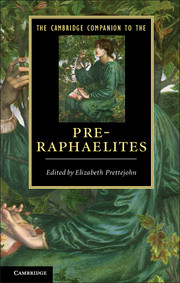Book contents
- Frontmatter
- Introduction
- PART ONE PRE-RAPHAELITISM
- PART TWO PRE-RAPHAELITES
- 6 The poetry of Dante Gabriel Rossetti (1828–1882)
- 7 The painting of Dante Gabriel Rossetti
- 8 William Holman Hunt (1827–1910)
- 9 John Everett Millais (1829–1896)
- 10 Ford Madox Brown (1821–1893)
- 11 Christina Rossetti (1830–1894)
- 12 Elizabeth Eleanor Siddall (1829–1862)
- 13 The writings of William Morris (1834–1896)
- 14 The designs of William Morris
- 15 Edward Burne-Jones (1833–1898)
- 16 Algernon Charles Swinburne (1837–1909)
- 17 William Michael Rossetti (1829–1919)
- 18 Envoi
- Appendix 1 The contents of The Germ
- Appendix 2 The Pre-Raphaelite ‘list of Immortals’
- Guide to further reading and looking
- Cambridge Companions to …
- Index
12 - Elizabeth Eleanor Siddall (1829–1862)
from PART TWO - PRE-RAPHAELITES
Published online by Cambridge University Press: 28 September 2012
- Frontmatter
- Introduction
- PART ONE PRE-RAPHAELITISM
- PART TWO PRE-RAPHAELITES
- 6 The poetry of Dante Gabriel Rossetti (1828–1882)
- 7 The painting of Dante Gabriel Rossetti
- 8 William Holman Hunt (1827–1910)
- 9 John Everett Millais (1829–1896)
- 10 Ford Madox Brown (1821–1893)
- 11 Christina Rossetti (1830–1894)
- 12 Elizabeth Eleanor Siddall (1829–1862)
- 13 The writings of William Morris (1834–1896)
- 14 The designs of William Morris
- 15 Edward Burne-Jones (1833–1898)
- 16 Algernon Charles Swinburne (1837–1909)
- 17 William Michael Rossetti (1829–1919)
- 18 Envoi
- Appendix 1 The contents of The Germ
- Appendix 2 The Pre-Raphaelite ‘list of Immortals’
- Guide to further reading and looking
- Cambridge Companions to …
- Index
Summary
In 1857, in a period of intense productive creativity, Elizabeth Siddall completed several watercolours. One of these, Clerk Saunders (Figure 15), portrays a scene recounted in an old Scottish ballad in which May Margaret meets the ghost of her murdered lover, the Clerk Saunders of the title. As May Margaret kisses the ‘chrystal wand’ to pledge of her fidelity, Clerk Saunders reaches out to receive it. In the dim light of the chamber, both figures appear ghostly and pale. Dawn breaks over the medieval city glimpsed through the aperture; on Margaret's prie-dieu, an hour-glass stands empty. It is a dramatic moment in which the dead confronts the living. With its literary inspiration, glowing textured watercolour and themes of love and desire, the image is exemplary of a major new direction of Pre-Raphaelite art. It is also exemplary of Pre-Raphaelite art in taking its inspiration from art before the High Renaissance, less the early Italian painters than Gothic art and medieval illumination. By the mid-1850s Siddall had developed a distinctive artistic style characterized by compositional layering, enclosed space, attenuated figures and jewel-like colours in which the furniture, dress and bulky folds of the drapery, as well as the execution in watercolour, all consciously rework pre-modern visual languages.
Clerk Saunders was one of a number of finished art works that the artist contributed to the exhibition of Pre-Raphaelite art, held at Russell Place in central London in the summer of 1857. This was one of several independent alternative shows to showcase Pre-Raphaelite art to a largely invited audience. By now Siddall had established a strong portfolio, working consistently in watercolour, as well as in pen and ink and pencil, and occasionally in oils, and her art was substantially represented. In the history of Pre-Raphaelitism, Siddall’s art, produced between 1852 and 1861, has three principal points of significance.
- Type
- Chapter
- Information
- The Cambridge Companion to the Pre-Raphaelites , pp. 183 - 195Publisher: Cambridge University PressPrint publication year: 2012

